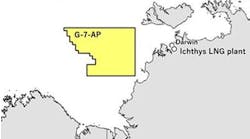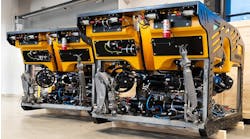AST delivers high-performance satellite communications
Though satellite communications are based quite literally on rocket science - transmitting voice, data, and video signals over satellites positioned nearly 23,000 mi above the earth - it is now considered a “mature” technology.
While serving a useful purpose, such conventional very small aperture terminal (VSAT) equipment used historically by the petroleum industry in remote areas, particularly offshore, has exhibited a long list of shortcomings. High cost, limited upload/download speeds, weather-related issues and design inefficiencies are just some of them.
Today, for remote exploration, production and transportation activities, the industry’s need is increasingly critical for real-time satellite communications applications that deliver both increased functionality and broader bandwidth. For the IP/Internet-based networks being used increasingly in remote oil and gas operations, including offshore, more efficient Advanced Satellite Technology (AST) equipment and services are available to meet those needs - and more.
Connection difficulties
Telecom designs, provisions and manages bandwidth connectivity between customers’ US locations and their very remote locations.
Karl Faller, president of Telecom International, Inc. of Charleston, SC, said that, historically, it has been difficult to run TCP/IP (Transmission Control Protocol/Internet Protocol) service on legacy satellite communications systems. However, an AST solution such as that supplied by Telecom International was developed specifically to address and solve that problem and its inherent drawbacks, which include:
• The effects of latency, “jitter,” and their impacts on real-time, interactive communications
• Weather-related issues, including raid fade
• Low upload/download speeds
“Latency - the amount of delay, measured in milliseconds, found in a round-trip data transmission to legacy TCP/IP receivers - often increases when sending devices mistake the usual ground-to-satellite-to-ground delay to be a congested circuit requiring a whole new transmission,” said Faller.
“The data packet is dropped midway through transmission,” he noted, “and must be retransmitted from the beginning.”
“However, AST provides bi-directional TCP/IP acceleration built into the satellite router and hub equipment at both the remote site and teleport hub equipment. Also, the data transmission is tracked and buffered, and occasional acknowledgements are sent end-to-end so that if an error does occur, only the corrupted portion need be re-sent,” he said.
Weather-related interruptions
“With the very low bit error rate requirement of TCP/IP systems, storms and other inclement weather changes sometimes degrade or lose the signal altogether,” said Faller. “And while forward error correction (FEC) technology does help correct errors to avoid retransmission, it carries a high overhead and lowers bandwidth efficiency.”
“AST uses a new technology called Turbo Product Codes (TPC) that essentially corrects most of the errors caused by weather interruptions and then re-sends the data, correcting any packet corruption that might have occurred during transmission,” said Faller.
“What’s more, TPC reduces the amount of power required for antennas to transmit signals to the satellite. That allows customers to use smaller, less-expensive antennas to support voice, data and Internet applications more cost-effectively.”
“So-called rain fade often results with conventional VSAT systems since they are limited in the amount of power that can be directed at the satellite,” said Faller. “As the weather degrades, there is a point at which this limited power is insufficient to reach the transponder, ultimately resulting in significant transmission errors and even failure of IP throughput.”
“The AST addresses this problem in two ways,” he said. “First, using TCP/IP forward error correction, significantly less power is required to deliver the same bandwidth as a legacy system, and it is armed with automatic power control that boosts transmission power as the signal degrades due to inclement weather without exceeding the power limits imposed by the transponder vendor. As the weather clears, the transmission power is throttled back, again automatically.”
Uplink performance
“Finally, IP/Internet services running through traditional satellites are optimized to support downloading large files rather than on upload performance. Therefore, such legacy systems must contend for bandwidth, leveraging technology that works much like shared Ethernet. However, as more users are added to the system, collisions result as multiple users request bandwidth at the same time,” said Faller.
“The AST system minimizes the uplink connect time by assigning a small amount of dedicated bandwidth to the router, so a VSAT never has to contend for access,” said Faller. “It always has a connection to the hub.”
“An additional pool of share bandwidth is allocated to each remote site up to 8 times/second using a ‘fair access’ algorithm to prevent high usage sites from starving other sites. With the AST, the time slots are constantly assigned and allocated in real time, which increases bandwidth efficiency to more than 95%.” “This provides bandwidth speeds of up to 18 mbps per second down and 8.4 mbps up,” he added.
“This is the largest amount of bandwidth service available in the satellite communications industry,” he said.•
For more information, contact Karl Faller at 843 856-5253, extension 203; email: [email protected].




